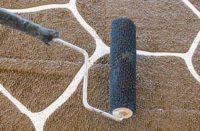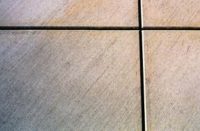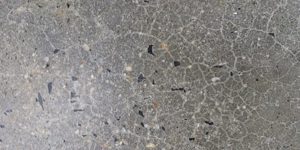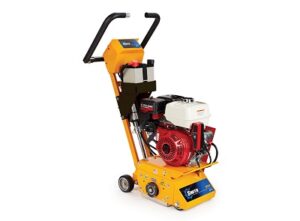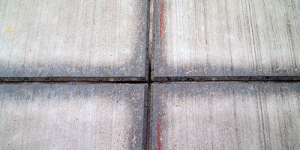
Diamonds may be forever in jewelry and James Bond movies, but when it comes to the workaday world, not so much.
If they were, a good diamond saw blade could be passed on from father to son. As it is, blades can be a regularly occurring purchase whether you’re doing surface engraving or cutting control joints.
And, while one option is to simply choose the blade that’s cheapest, professionals know the quality of their cuts defines them. A little knowledge and research can mean better cuts and a better reputation.
Close to forever
They may not last forever, but diamond blades have one big advantage over the competition.
“They don’t wear as fast in diameter as some other abrasive blades,” says Darrel Adamson, owner of Engrave-A-Crete in Mansfield, Missouri. “Diamonds are an abrasive blade, but they last longer than, say, a carborundum blade.”
(Carborundum, a trade name for the artificial crystal silicon carbide, is not as hard as an industrial diamond.)
Although there is more than one way to manufacture diamond blades, the most popular is what’s referred to as an eroding segment diamond blade, according to Dave Glynn, vice president of U.S. Saws in Tampa, Florida.
“They take a certain amount of manmade industrial diamonds and mix it with a matrix of metal powder than can be made from several different things, including copper, tin or nickel,” Glynn explains. “They take the matrix and the diamonds, heat it up and put it under a tremendous amount of pressure so it forms a segment.”
Once a segment is formed, it is then welded to a blade core. Another method called electroplated or vacuum-brazed may also be used.

It’s also important to realize that diamond blades don’t really cut.
“They grind the material through the action of friction surrounding the diamonds and matrix,” says Bruce Coleman, a product manager with Multiquip in Carson, California. “This process eventually cracks or fractures the diamond particle, breaking it down into smaller pieces. As the diamond particles break down, the metal bond matrix also begins to wear.”
The bottom line is that larger particles of soft, abrasive materials wear down a matrix faster than the small particles removed from hard, dense materials. In both cases, however, it’s important to have a diamond-and-matrix mix that will continue to erode at a good rate to expose the diamonds embedded in the matrix.
Know your job
There are several different conditions of concrete that need to be considered in choosing the best blade. Topping the list is whether the job will be done on green or cured concrete.
Bryan Jones, a product manager with Husqvarna in Olathe, Kansas, says blades for cutting green concrete typically have a harder bond because green concrete is much more abrasive than cured concrete.
“When the concrete is green, and the blade is cutting through it, the sand can move around without being ground away,” Jones says. “That makes it much more abrasive on the blade than cured concrete, where you’re moving the sand out, rather than moving it across the face of a diamond segment.”
Still another consideration is whether you’re cutting wet or dry. While dry cutting is losing some popularity due to the increasing strictness of the federal Occupational Safety and Health Administration’s regulations on silica dust, dry cutting does continue at some job sites.
There are blades that are made specifically for dry cutting, says Jones.
“You can wet-cut with just about any diamond blade out there, but you can only dry cut with a limited number of them,” he says. “And, that’s usually with smaller-diameter blades and lower-horsepower saws.”

Multiquip’s Coleman adds that not only does wet cutting mitigate dust, but it also provides positive cooling protection to the steel core of the blade.
A saw’s horsepower also has an impact. For instance, Engrave-A-Crete’s Adamson notes that concrete engraving is typically done with lower-horsepower saws because while the goal is to wear away concrete near the surface, deep cutting isn’t required.
“Horsepower is a big issue in blade selection,” says U.S. Saw’s Glynn. “You also need to know how deep you’re going to be cutting and how fast your saw is turning. There’s a certain rpm (revolutions-per-minute) limit to every sized blade.”
Weighing the options
As with so many other purchases, when shopping for diamond blades, it first helps if you can define what you want that blade to do or, more specifically, its purpose.
“Are you going to be doing something decorative or cutting expansion joints into concrete,” asks Rick Lobdell of Concrete Mystique in Nashville, Tennessee. “You need to know what size blade you need to fit your saw, what depth you’re going to be cutting and what width.”
Sadly, a visual inspection of blades at a tradeshow isn’t going to provide all the answers. It’s an area where seeing isn’t necessarily believing, although Adamson says it won’t necessarily hurt.
“If you know a couple of things about the blades you can probably look at the surface and see the size of a segment and the depth of the segment,” he says. “You can look at the edge of the blade and see if it looks like there’s any sort of diamond concentration, and you can look at the color.”
Lobdell believes a keen observer can see differences between blades, although seeing the differences in the number of diamonds present probably isn’t possible.
“You will notice a size difference,” Lobdell says. “And, when you go to test them, you’ll feel there’s something different about the different segments.”
Because the blades are so important to the product if you’re sawing concrete, the best decisions are based on research, research and more research. Fortunately, both the internet and the blade manufacturers themselves are happy to provide information.
“They’re looking to make sales, so they’re very thorough in trying to understand what you’re looking for,” says Lobdell. “A lot of them will send you a blade to test out to see if you like it. Get to know your sales reps and talk to them.”
Finding someone near your location is particularly helpful because they’re going to have experience with the sand and the aggregate in the concrete found in your area.
Additionally, U.S. Saws’ Glynn says by talking to the company from whom you bought the saw, it’s going to have a good idea of what will work best with its machine.

“We’ve done a lot of testing with different blades and different surfaces, so we have a lot of experience,” Glynn says. “Not only that, but by talking to customers on a day-to-day basis, we have a lot of their experiences, as well.”
Don’t hesitate to do your own testing. Husqvarna’s Jones recommends starting out with your manufacturer’s recommended blade, but don’t be afraid to branch out from there.
“Do your own experiments,” he says. “If you’re a professional cutter, you’re going to go through a lot of diamond blades per year. Run side-by-side comparisons and keep track of your footages. That way you’ll know what’s the best blade for your piece of equipment.”
Engrave-A-Crete’s Adamson agrees.
“Don’t just log the manufacturer and the blade design, but log what was in the concrete,” Adamson says. “Did it have large aggregate or small, did it have mesh in it or rebar? And, track how many inch-feet (linear feet times the depth in inches) you cut.”
It’s also important to remember that the total value of a diamond blade purchase is not measured by cost alone. Multiquip’s Coleman notes that most manufacturers offer the same size blade in different grades — often economical, standard, premium, supreme and professional — to provide options to best fit with the tool’s value as defined by speed-of-cut and operational life.
“Generally, and depending on the diamond tool being used, the higher-grade blades tend to provide higher degrees of cutting efficiency and tool life,” he says.
Adamson puts it slightly differently.
“The right blade is a balance between labor and the cost of the diamonds,” he says. “If you choose a blade that’s cheap but takes forever to cut something, it slows you down, costs more in labor and even gasoline if you’re running a gas saw. It’s a false economy and a lost opportunity.”
www.concretemystique.com
www.csda.org
www.engraveacrete.com
www.husqvarnacp.com
www.multiquip.com
www.ussaws.com

